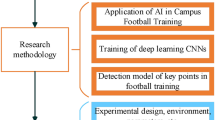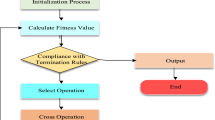Abstract
The research is conducted to improve the efficiency of college football training. The long short-term memory (LSTM) + genetic algorithm (GA) is proposed based on deep learning and internet of things (IoT) intelligent wearable devices. Specifically, the LSTM makes up for the weak local searchability of GA. The research idea is to use LSTM–GA to train and simulate the network model. The experimental result reads: the LSTM–GA model converges at the 101st iteration. The model fitness is about 11% higher than GA and about 2% higher than the LSTM. Thus, the proposed LSTM–GA can plan football players' trajectory to score. Therefore, players can wear IoT-ready intelligent wearable devices to plan the optimal shooting trajectory. The research contribution is to optimize the LSTM–GA model of IoT-ready intelligent wearable devices. The proposal can improve the efficiency of college football training.













Similar content being viewed by others
Data availability
The raw data supporting the conclusions of this article will be made available by the authors, without undue reservation.
References
Hui L, Hdjab C, Bo Y et al (2019) An analysis of research hotspots and modeling techniques on carbon capture and storage. Sci Total Environ 687:687–701. https://doi.org/10.1016/j.scitotenv.2019.06.013
Taghavifar H, Xu B, Taghavifar L et al (2019) Optimal path-planning of nonholonomic terrain robots for dynamic obstacle avoidance using single-time velocity estimator and reinforcement learning approach. IEEE Access 7:1–1. https://doi.org/10.1109/ACCESS.2019.2950166
Santos L, Santos F, Mendes J et al (2020) Path planning aware of robot’s center of mass for steep slope vineyards. Robotica 38(4):684–698. https://doi.org/10.1017/S0263574719000961
Hao L, Ma G, Dong J (2020) Path planning method of anti-collision for the operation road of port cargo handling robot. J Coastal Res 103(sp1):892. https://doi.org/10.2112/SI103-185.1
Hernández-Mejía C, Vázquez-Leal H, Torres-Muoz D (2020) A novel collision-free path planning modeling and simulation methodology for robotical arms using resistive grids. Robotica 38(7):1176–1190. https://doi.org/10.1017/S0263574719001310
Cheng KP, Mohan RE, Nhan N et al (2020) Multi-objective genetic algorithm-based autonomous path planning for hinged-tetro reconfigurable tiling robot. IEEE Access. https://doi.org/10.1109/ACCESS.2020.3006579
Kumar PB, Rawat H, Parhi DR (2019) Path planning of humanoids based on artificial potential field method in unknown environments. Expert Syst 36(2):1–12. https://doi.org/10.1111/exsy.12360
Chen J, Wang P, Wang H (2021) Pedestrian-induced load identification from structural responses using genetic algorithm with numerical and experimental validation. J Bridg Eng 26(3):04021001. https://doi.org/10.1061/(ASCE)BE.1943-5592.0001687
Nowakowski P, Szwarc K, Boryczka U (2018) Vehicle route planning in e-waste mobile collection on demand supported by artificial intelligence algorithms. Transp Res Part D Transp Environ 63:1–22. https://doi.org/10.1016/j.trd.2018.04.007
Manoharan S (2019) An improved safety algorithm for artificial intelligence enabled processors in self driving cars. J Artif Intell 1(02):95–104
Ajeil FH, Ibraheem IK, Azar AT et al (2020) Grid-based mobile robot path planning using aging-based ant colony optimization algorithm in static and dynamic environments. Sensors 20(7):1880. https://doi.org/10.3390/s20071880
Jacob IJ, Darney PE (2021) Artificial bee colony optimization algorithm for enhancing routing in wireless networks. J Artif Intell 3(01):62–71. https://doi.org/10.36548/jaicn.2021.1.006
AlJanabi S, Alkaim A (2022) A novel optimization algorithm (Lion-AYAD) to find optimal DNA protein synthesis. Egypt Inform J. https://doi.org/10.1016/j.eij.2022.01.004
Hao K, Zhao J, Yu K et al (2020) Path planning of mobile robots based on a multi-population migration genetic algorithm. Sensors 20(20):5873. https://doi.org/10.3390/s20205873
Yurek S, Eaton MJ, Lavaud R et al (2021) Modeling structural mechanics of oyster reef self-organization including environmental constraints and community interactions. Ecol Model 440:109389. https://doi.org/10.1016/j.ecolmodel.2020.109389
Votion J, Cao Y (2019) Diversity-based cooperative multivehicle path planning for risk management in costmap environments. IEEE Trans Ind Electron 66(8):6117–6127. https://doi.org/10.1109/TIE.2018.2874587
Xu C, Shen J, Du X et al (2018) An intrusion detection system using a deep neural network with gated recurrent units. IEEE Access 6:48697–48707. https://doi.org/10.1109/ACCESS.2018.2867564
Jonker D, Langevin S (2017) System and method for large scale information processing using data visualization for multi-scale communities. Google Patents, pp 2859–2864
Nguyen Mau T, Inoguchi Y (2020) Locality-sensitive hashing for information retrieval system on multiple GPGPU devices. Appl Sci 10(7):2539. https://doi.org/10.3390/app10072539
Saritha RR, Paul V, Kumar PG (2019) Content based image retrieval using deep learning process. Clust Comput 22(2):4187–4200. https://doi.org/10.1007/s10586-018-1731-0
Sawyer MW, Buchmann C, Kalbaugh CA (2015) Examining the impact of helmet orientation visual cues on the passing effectiveness of quarterbacks in american football. Procedia Manuf 3:1181–1186. https://doi.org/10.1016/j.promfg.2015.07.196
Tu X, Xie W, Chen Z et al (2021) Analysis of deep neural network models for inverse design of silicon photonic grating coupler. J Lightw Technol. https://doi.org/10.1109/JLT.2021.3057473
Morgan M, Braasch J (2020) Holistic, long-term soundscape monitoring in Upstate New York using convolutional long short-term memory deep neural networks. J Acoust Soc Am 148(4):2740–2740. https://doi.org/10.1121/1.5147610
Radha M, Fonseca P, Moreau A et al (2019) Sleep stage classification from heart-rate variability using long short-term memory neural networks. Sci Rep 9(1):14149. https://doi.org/10.1038/s41598-019-49703-y
Jiang T, Zhan C, Yang Y (2019) Long short-term memory network with external memories for image caption generation. J Electron Imaging 28(2):1. https://doi.org/10.1117/1.JEI.28.2.023022
Yu H, Xu Z, Zhou G et al (2020) Soil carbon release responses to long-term versus short-term climatic warming in an arid ecosystem. Biogeosciences 17(3):781–792. https://doi.org/10.5194/bg-17-781-2020
Tan Y, Zhao G (2019) Transfer learning with long short-term memory network for state-of-health prediction of lithium-ion batteries. IEEE Tran Ind Electron 67(10):8723–8731. https://doi.org/10.1109/TIE.2019.2946551
Sepas-Moghaddam A, Etemad A, Pereira F et al (2021) Long short-term memory with gate and state level fusion for light field-based face recognition. IEEE Trans Inf Forensics Secur 16:1365–1379. https://doi.org/10.1109/TIFS.2020.3036242
Du G, Wang Z, Gao B et al (2020) A convolution bidirectional long short-term memory neural network for driver emotion recognition. IEEE Trans Intell Transp Syst. https://doi.org/10.1109/TITS.2020.3007357
Cao Y, Fan X, Guo Y et al (2020) Multi-objective optimization of injection-molded plastic parts using entropy weight, random forest, and genetic algorithm methods. J Polym Eng 40(4):360–371. https://doi.org/10.1515/polyeng-2019-0326
Mendoza VN, Ledeneva Y, García-Hernández RA (2020) Unsupervised extractive multi-document text summarization using a genetic algorithm. J Intell Fuzzy Syst 39(2):1–12. https://doi.org/10.3233/JIFS-179900
Deng B (2020) Word order detection in English classroom teaching based on improved genetic algorithm of block coding. J Intell Fuzzy Syst 40(6):1–12. https://doi.org/10.3233/JIFS-189521
Zhi BE, Shi R, Gan L et al (2021) Multi-satellites imaging scheduling using individual reconfiguration based integer coding genetic algorithm. Acta Astronaut 178:645–657. https://doi.org/10.1016/j.actaastro.2020.08.041
Khan AH, Li S, Luo X (2020) Obstacle avoidance and tracking control of redundant robotic manipulator: an RNN-based metaheuristic approach. IEEE Trans Ind Inf 16(7):4670–4680. https://doi.org/10.1109/TII.2019.2941916
Li Y, Zheng J (2020) Research on real-time obstacle avoidance planning for an unmanned surface vessel based on the grid cell mechanism. J Navig 73(6):1358–1371. https://doi.org/10.1017/S0373463320000338
Acuna Y, Sun Y (2020) An efficiency-improved genetic algorithm and its application on multimodal functions and a 2D common reflection surface stacking problem. Geophys Prospect 68(4):1189–1210. https://doi.org/10.1111/1365-2478.12920
Jung S, Pyeon JH, Lee HS et al (2020) Construction cost estimation using a case-based reasoning hybrid genetic algorithm based on local search method. Sustainability 12(19):7920. https://doi.org/10.3390/su12197920
Yasojima EK, Celio L, Teixeira ON et al (2019) CAM-ADX: a new genetic algorithm with increased intensification and diversification for design optimization problems with real variables. Robotica 37(9):1–46. https://doi.org/10.1017/S026357471900016X
Wang Y, Zhang N, Chen X et al (2021) A short-term residential load forecasting model based on LSTM recurrent neural network considering weather features. Energies 14(10):2737. https://doi.org/10.3390/en14102737
Saleh K, Hossny M, Nahavandi S (2017) Intent prediction of vulnerable road users from motion trajectories using stacked LSTM network. In: 2017 IEEE 20th international conference on intelligent transportation systems (ITSC). IEEE, 2017, pp 327–332. https://doi.org/10.1109/ITSC.2017.8317941
Panchanathan S, Chakraborty S, McDaniel T et al (2017) Enriching the fan experience in a smart stadium using internet of things technologies. Int J Semant Comput 11(02):137–170. https://doi.org/10.1142/S1793351X17400062
Al Janabi S, Yaqoob A, Mohammad M (2019) Pragmatic method based on intelligent big data analytics to prediction air pollution. In: International conference on big data and networks technologies. Springer, Cham, pp 84–109. https://doi.org/10.1007/978-3-030-23672-4_8
Al-Janabi S, Alkaim A, Al-Janabi E et al (2021) Intelligent forecaster of concentrations (PM2.5, PM10, NO2, CO, O3, SO2) caused air pollution (IFCsAP). Neural Comput Appl 33(21):14199–14229. https://doi.org/10.1007/s00521-021-06067-7
AlJawadi R, Studniarski M, Younus A (2018) New genetic algorithm based on dissimilarities and similarities. Comput Sci. https://doi.org/10.7494/csci.2018.19.1.2522
Arora S, Singh S (2019) Butterfly optimization algorithm: a novel approach for global optimization. Soft Comput 23(3):715–734. https://doi.org/10.1007/s00500-018-3102-4
Faramarzi A, Heidarinejad M, Stephens B et al (2020) Equilibrium optimizer: a novel optimization algorithm. Knowl Based Syst 191:105190. https://doi.org/10.1016/j.knosys.2019.105190
Author information
Authors and Affiliations
Corresponding author
Additional information
Publisher's Note
Springer Nature remains neutral with regard to jurisdictional claims in published maps and institutional affiliations.
Rights and permissions
About this article
Cite this article
Guan, Y., Qiu, Y. & Tian, C. Trajectory planning in college football training using deep learning and the internet of things. J Supercomput 78, 18616–18635 (2022). https://doi.org/10.1007/s11227-022-04619-9
Accepted:
Published:
Issue Date:
DOI: https://doi.org/10.1007/s11227-022-04619-9




